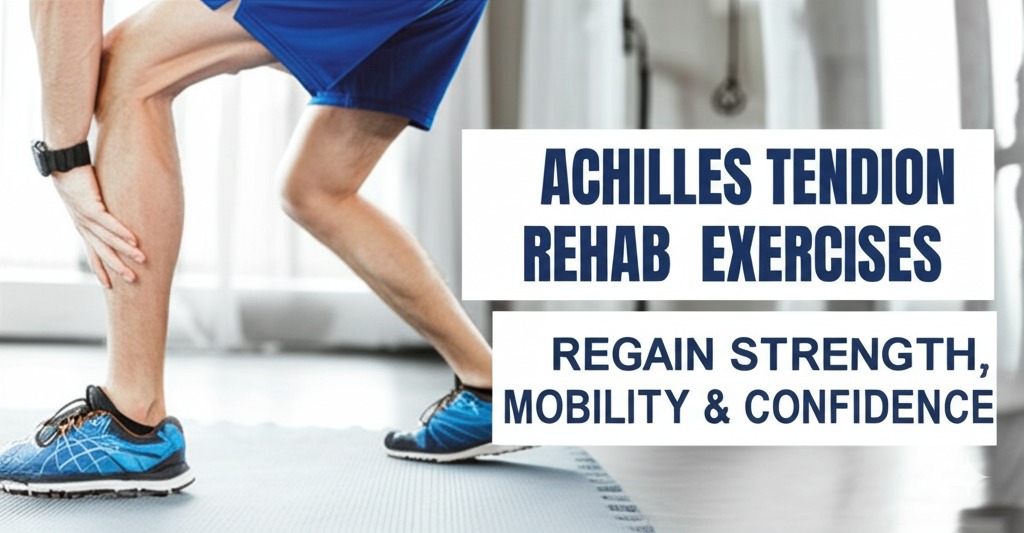When your Achilles tendon—the strongest tendon in your body—gets injured, it can feel like your movement and freedom have hit a wall. Whether it’s due to overuse, a partial tear, or post-surgery recovery, proper rehabilitation exercises are key to bouncing back. In this guide, we’ll walk you through the most effective Achilles tendon rehab exercises, tailored to each stage of healing, helping you regain strength, mobility, and confidence.
Understanding Achilles Tendon Injuries
The Achilles tendon connects your calf muscles to your heel bone and is vital for walking, running, and jumping. Injuries often occur from:
- Sudden increases in physical activity
- Tight calf muscles
- Improper footwear
- Lack of warm-up before intense activity
Common injuries include Achilles tendinitis, tendinosis, and Achilles tendon rupture. Rehab exercises play a crucial role in recovery and preventing re-injury.
Key Principles of Achilles Tendon Rehabilitation
Before diving into exercises, it’s essential to follow a few guiding principles:
- Progress gradually: Start with low-impact movements and advance as healing occurs.
- Listen to your body: Pain is a signal—if it hurts, modify or pause the exercise.
- Prioritize mobility, then strength: Regain range of motion before building power.
- Stay consistent: Daily or regular practice yields the best results.
Phase 1: Early Recovery (Acute Phase)
This phase focuses on reducing inflammation and maintaining mobility.
1. Ankle Alphabet
Gently improve ankle range of motion.
- Sit with your leg extended.
- “Draw” the alphabet in the air with your big toe.
- Repeat 1–2 times per day.
2. Towel Stretch
Helps maintain flexibility in the Achilles tendon and calf.
- Sit with your leg straight.
- Loop a towel around your foot and gently pull toward you.
- Hold for 20–30 seconds, repeat 3 times per leg.
3. Isometric Calf Contractions
Begin activating calf muscles without movement.
- Sit or lie down with your leg straight.
- Push your foot gently against a fixed surface (e.g., wall).
- Hold for 5–10 seconds, repeat 10 times.
Phase 2: Intermediate Recovery (Subacute Phase)
Here, the goal is to restore strength and flexibility.
4. Heel Raises
Strengthen calf and Achilles tendon.
- Stand with feet shoulder-width apart.
- Slowly rise onto the balls of your feet, then lower.
- Start with both feet, progress to one leg.
- Perform 2–3 sets of 10–15 reps.
5. Eccentric Heel Drops
Excellent for rebuilding tendon resilience.
- Stand on a step with heels off the edge.
- Rise with both feet, then slowly lower one heel.
- Perform 2–3 sets of 10 reps, daily.
6. Resistance Band Plantar Flexion
Target specific ankle muscles.
- Sit with your leg extended.
- Loop a resistance band around your foot.
- Push your foot away, then slowly return.
- 2–3 sets of 15 reps.
Phase 3: Advanced Recovery (Return to Activity)
This stage reintroduces functional movement and sport-specific training.
7. Single-Leg Balance
Improves ankle stability and proprioception.
- Stand on one leg for 30 seconds.
- Make it harder by closing your eyes or standing on a cushion.
- Repeat 2–3 times per leg.
8. Step-Ups
Rebuilds coordination and strength.
- Step onto a low platform or stair.
- Push through your heel to rise, then lower slowly.
- 2–3 sets of 10 reps per leg.
9. Jump Rope or Light Hops
Gradually reintroduce plyometrics.
- Start with 10–20 seconds of light hops or jump rope.
- Progress in duration and intensity as tolerated.
Tips for a Safe and Successful Recovery
- Warm up before exercising and stretch afterward.
- Hydrate well and eat anti-inflammatory foods to support healing.
- Consider working with a physical therapist for a personalized plan.
- Avoid overtraining—give your tendon time to recover between sessions.
When to Seek Professional Help
If you experience:
- Persistent or worsening pain
- Swelling that doesn’t subside
- Difficulty walking or standing
- Recurrent injuries
…it’s important to consult a healthcare provider or physical therapist.
Final Thoughts: Reclaim Your Strength
Recovering from an Achilles tendon injury isn’t a sprint—it’s a gradual journey. But with the right exercises, patience, and consistency, you can come back stronger than ever. Incorporate these rehab exercises into your routine and monitor your progress. And if you’re unsure about your recovery plan, don’t hesitate to seek expert guidance.
Start today, take it slow, and trust the process—your Achilles has your back (well, your heel!).

Kallie Snyder is an author at Stonegate Health Rehab, providing valuable insights, recovery guidance, and rehab resources to help individuals achieve better health and well-being.
